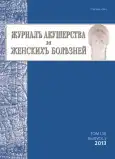Influenza A virus reproduction in humanendometrial cells
- Authors: Durnova A.O.1, Kadyrova R.A.2, Danilenko D.M.2, Dyukov M.I.2, Martyntseva V.A.2, Smirnova T.D.2, Yeropkin M.Y.2, Kiselev O.I.2
-
Affiliations:
- D. O. Ott Research Institute of Obstetrics and Gynecology, RAMS
- Research Institute of Influenza
- Issue: Vol 62, No 2 (2013)
- Pages: 23-28
- Section: Articles
- URL: https://journals.rcsi.science/jowd/article/view/2632
- DOI: https://doi.org/10.17816/JOWD62223-28
- ID: 2632
Cite item
Full Text
Abstract
Full Text
##article.viewOnOriginalSite##About the authors
Anna Olegovna Durnova
D. O. Ott Research Institute of Obstetrics and Gynecology, RAMS
Email: anna.durnova@gmail.com
PhD, senior researcher of the Laboratory of Cell Biology, the Department of Pathomorphology
Renata Anvarovna Kadyrova
Research Institute of Influenzajunior researcher of the Laboratory of Cell Cultures
Darya Mikhaylovna Danilenko
Research Institute of Influenza
Email: daria.baibus@gmail.com
researcher of the Laboratory of Evolutionary Changeability of Influenza Viruses
Maksim Igorevich Dyukov
Research Institute of Influenzaresearcher of the Laboratory of Molecular Virology and Genetic Engineering
Vera Aleksandrovna Martyntseva
Research Institute of Influenzajunior researcher of the Laboratory of Cell Cultures
Tatyana Dmitriyevna Smirnova
Research Institute of Influenza
Email: cellcultures@influenza.spb.ru
PhD, leading researcher of the Laboratory of Cell Cultures
Mikhail Yuryevich Yeropkin
Research Institute of InfluenzaDoctor of Science, head of the Laboratoty of Evolutionary Changeability of Influenza Viruses
Oleg Ivanovich Kiselev
Research Institute of Influenzaacademician, professor, director of the Research Institute of Influenza
References
- Влияние различных инфицирующих доз вирусов гриппа А на пролиферацию перевиваемых клеток человека /Смирнова Т. Д. [и др.] // Клеточные культуры. Информационный бюллетень. — 2011. — Т. 27. — С. 3–12.
- Гендон Ю. З. Проблемы профилактики гриппа у беременных женщин и новорожденных детей // Вопросы вирусологии. — 2009. — №. 4. — С. 4–7.
- Даниленко Д. М., Дурнова А. О., Кадырова Р. А. Дозозависимое влияние вируса гриппа А на клеточный цикл // Медицинский академический журнал. — 2012, прилож. — С. 314.
- Киселев О. И., Покровский В. И. Грипп при беременности: сочетание функциональной и инфекционной иммуносупрессии. — СПб., 2012. — 146 с.
- Разработка модели взаимоотношений вируса гриппа А с перевиваемыми лимфобластоидными клетками человека для изучения биологических особенностей вируса и определения активности антивирусных препаратов /Смирнова Т. Д. [и др.] // Клеточные культуры. Информационный бюллетень. — 2009. — Т. 24. — С. 25–34.
- Соколов Д. И., Сельков С. А. Иммунологический контроль формирования сосудистой сети плаценты. — СПб.: Изд-во Н-Л, 2012. — 208 с.
- Apoptosis in cultured human fetal membrane cells infected with influenza virus / Uchide N. [et al.] // Biol. Phaem. Bull. — 2002. — Vol. 25. — P. 109–114.
- Apoptosis in human endometrium and endometriosis / Harada T. [et al] // Human Reproduction Update. — 2004. — Vol. 10, N 1. — P. 29–38.
- Bcl-2 alters influenza virus yield, spread abd hemmaglutinin glycosylation / Olsen C. [et al.] // J. Virol. — 1996. — Vol. 70. — P. 663–666.
- Bondza P. K., Maheux R., Akoum A. Insights into endometriosis-associated endometrial dysfunctions: a review // Front. Biosci. — 2009. — Vol. 1. — P. 415–428.
- Curry T. E., Osteen K. G. The matrix metalloproteinase system: changes, regulation and impact throughout the ovarian and uterine reproductive cycle // Endocr. Rev. — 2003. — Vol. 24. — P. 428–465.
- H1N1 2009 and seasonal H1N1 influenza virus-infected patients / Chen H. X. [et al.] // Human Immunology. — 2011. — Vol. 72. — P. 159–165.
- Hant J., Langat D. HLA-G: a human pregnancy-related immunomodulator // Current Opinion in Pharmacology. — 2009. — Vol. 9. — P. 462–469.
- He Y., Xu K., Keiner B. Influenza A virus replication induces Cell Cycle arrest in G0/G1 Phase // J. Virol. — 2010. — Vol. 84. — P. 12832–12840.
- HLA-G promotes immune tolerance / Rouas-Freiss N. [et al] //J. Biol. Regul. Homeost. Agent. — 2000. — Vol. 14. — P. 93–98.
- Induction of cell surface human leukocyte antigen-G expression in pandemic H1N1 2009 and seasonal H1N1 influenza virus-infected patients / Chen H. X. [et al] // Hum. Immunol. — 2011. — Vol. 72, N 2. — P. 159–165.
- Possible roles of proinflammatory and chemoattractive cytokines produced by human fetal membrane cells in the pathlogy of adverse pregnancy outcomes associated with influenza virus infection / Uchide N. [et al.] // Mediators of Inflammation. — 2012. — Vol. 2012. — P. 3–32.
- Progressive apoptosis in chorion leave trophoblast cells of human fetal membrane tissues during in vitro incubation is suppressed by antioxidative reagents / Ohyama K. [et al.] //Eur. J. Biochem. — 2001. — Vol. 267. — P. 6182–6189.
- Role for proteases and HLA-G in the pathogenicity of influenza A viruses / Foucault M.-L. [et al.] // J. Clin. Virology. — 2011. — Vol. 51. — P. 155–159.
- Role of host cellular proteases in the pathogenesis of influenza and influenza-induced multiple organ failure / Kido H. [et al.] // Biochimica et Biophysica Acta. — 2012. — Vol. 1824. — P. 186–194.
- Sweet C., Smith H. Pathogenicity of influenza virus // Microbiological Reviews. — 1980. — Vol. 44. — P. 303–330.
Supplementary files







